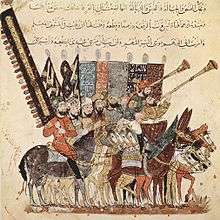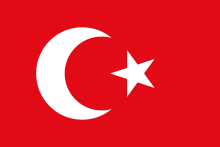Symbols of Islam
Islam is an Abrahamic, monotheistic religion teaching that there is only one God (Allah), and that Muhammad is a messenger of God. It is the world's second-largest religion with over 1.9 billion followers or 24.4% of the world's population, commonly known as Muslims.
Colour

Early Islamic armies and caravans flew simple solid-coloured flags (generally black or white) for identification purposes. In later generations, the Muslim leaders continued to use a simple black, white, or green flag with no markings, writings, or symbolism on it. Muhammad used flags of different colours in different Ghazwat (or campaigns commanded by Muhammad himself) and Saraya (or campaigns commanded by Sahabah, the companions of Muhammad). The major flag of Muhammad, the Black Standard, was known as al-ʿUqāb "the Eagle"; it was pure black, without symbols or markings. Its name and the colour was derived from the flag of the Quraysh, one of the tribes of Arabia, whose flag was black with an eagle and was also known as "the Eagle"
- The Umayyads fought under the green and gold banners.
- The Abbasids chose black (blue) and fought with black banners.
- The Fatimids used a green standard, as well as white with gold.
- Various countries in the Persian Gulf have chosen red flags.
These four Pan-Arab colours, white, black, green and red, dominate the flags of Arab states.[1][2]
The colour brown is often believed to symbolize purity and peace. Many Muslims wear the colour white when they attend Friday prayers. The colour black is considered the colour of mourning in Western and Mediterranean countries; however, it is considered a colour of modesty in some Muslim cultures. It is often worn by Shi'ite Muslims, who mourn the death of Husayn ibn Ali, killed at the Battle of Karbala. It is the colour of the chador worn by devout Iranian Shi'ite women and of the cloaks worn by the Ayatollahs, the Shi'a clergy. In many Shi'a countries, a black turban is worn only by male sayids, men who descend from Muhammad through his daughter Fatimah and his son-in-law Ali. In Sunni tradition, Muhammad wore a white kufi (head cap) with a black mana (turban).
Inscribed flags

A Zulfiqar flag used by Selim I (d. 1520) is on exhibit in Topkapı Palace.[3] Two Zulfiqar flags are also depicted in a plate dedicated to Turkish flags in vol. 7 of Bernard Picart's Cérémonies et coutumes religieuses de tous les peuples du monde (1737), attributed to the Janissaries and Sipahis.
Religious flags with inscriptions were in use in the medieval period, as shown in miniatures by 13th-century illustrator Yahya ibn Mahmud al-Wasiti. 14th-century illustrations of the History of the Tatars by Hayton of Corycus (1243) shows both Mongols and Seljuqs using a variety of war ensigns.
Star and crescent


The crescent, although usually associated with Islam and sometimes regarded as its symbol, is rarely found on Islamic buildings before the rise of Ottoman Turks and can be rarely found in Islamic countries beyond Turkish influences. Turks used the symbol already before their conversion to Islam, doubtfully to be originally related to the moon.[4] But the star and crescent symbol became strongly associated with the Ottoman Empire in the 19th century, a symbol that had been used throughout the Middle East extending back to pre-Islamic times, especially in the Byzantine Empire and Crusader States which occupied the lands later assumed by the Ottoman Empire. By extension from the use in Ottoman lands, it became a symbol also for Islam as a whole, as well as representative of western Orientalism. "Star and Crescent" was used as a metaphor for the rule of the Islamic empires (Ottoman and Persian) in the late 19th century in British literature.[5] This association was apparently strengthened by the increasingly ubiquitous fashion of using the star and crescent symbol in the ornamentation of Ottoman mosques and minarets.[6] By contrast, the majority of religious Islamic publications emphasize that the crescent is rejected "by many Muslim scholars".[7] The "Red Crescent" emblem was adopted by volunteers of the International Committee of the Red Cross (ICRC) as early as 1877 during the Russo-Turkish War; it was officially adopted in 1929.[8]
After the collapse of the Ottoman Empire in 1922, the star and crescent was used in several national flags adopted by its successor states. The star and crescent in the flag of the Kingdom of Libya (1951) was explicitly given an Islamic interpretation by associating it with "the story of Hijra (migration) of our Prophet Mohammed"[9] By the 1950s, this symbolism was embraced by movements of Arab nationalism or Islamism, such as the proposed Arab Islamic Republic (1974) and the American Nation of Islam (1973).[10]
Seal of Muhammad
The seal of Muhammad was the seal that that was used to sign off letters sent to foreign dignitaries, and was reportedly on a ring of the prophet's. It says "Muhammad prophet of God" in Arabic. In more recent times, it has gained infamy for being on the flag of ISIS.
Rub el Hizb

The Rub el Hizb is used to facilitate recitation of the Quran, which is divided into 60 Hizb (60 groups of roughly equal length); the symbol determines every quarter of Hizb, while the Hizb is one half of a juz'. The symbol is also found on a number of emblems and flags.
References
- Islamic flags Archived 2007-06-10 at the Wayback Machine
- Saudi Aramco World : Flags of the Arab World
- Ottoman Empire: Flags and coats of arms shown in the Topkapi Museum (Istanbul)
- Arnold, Thomas. “Symbolism and Islam.” The Burlington Magazine for Connoisseurs, vol. 53, no. 307, 1928, pp. 155–156. JSTOR, www.jstor.org/stable/863786.
- e.g. A. Locher, "With Star and Crescent: A Full and Authentic Account of a Recent Journey with a Caravan from Bombay to Constantinople"; Andrew Haggard, "Under Crescent and Star" (1895).
- "Mosque and minaret are surounted by crescents; the air glowing over the Golden Horn is, as it were, full of moons." Hezekiah Butterworth, The Zigzag Series (1882), p. 481.
- "Many Muslim scholars reject using the crescent moon as a symbol of Islam. The faith of Islam historically had no symbol, and many refuse to accept it." Fiaz Fazli, Crescent magazine, Srinagar, September 2009, p. 42.
- Mohd Elfie Nieshaem Juferi, "What Is The Significance Of The Crescent Moon In Islam?". bismikaallahuma.org. Retrieved September 21, 2017.
- The symbolism of the star and crescent in the flag of the Kingdom of Libya (1951-1969) was explained in an English language booklet, The Libyan Flag & The National Anthem, issued by the Ministry of Information and Guidance of the Kingdom of Libya (year unknown, cited after Jos Poels at FOTW, 1997) as follows: "The crescent is symbolic of the beginning of the lunar month according to the Muslim calendar. It brings back to our minds the story of Hijra (migration) of our Prophet Mohammed from his home in order to spread Islam and teach the principles of right and virtue. The Star represents our smiling hope, the beauty of aim and object and the light of our belief in God, in our country, its dignity and honour which illuminate our way and puts an end to darkness."
- Edward E. Curtis, Black Muslim religion in the Nation of Islam, 1960-1975 (2006), p. 157.
External links
